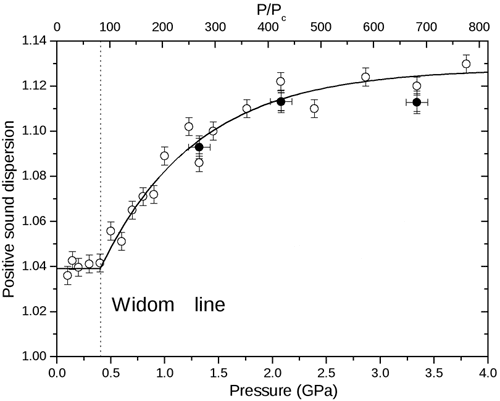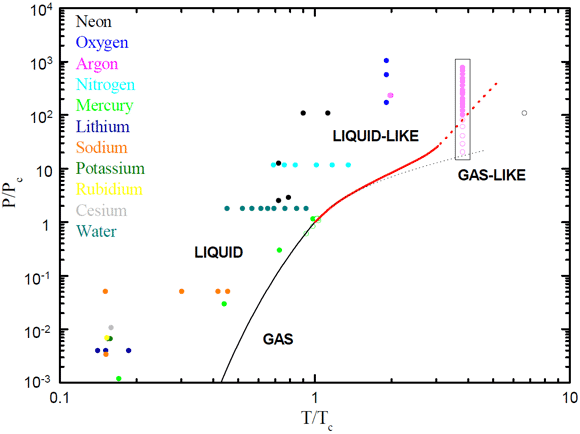- Home
- News
- Spotlight on Science
- New phases in supercritical...
New phases in supercritical fluids: the Widom line as crossover between liquid-like and gas-like behaviour
15-09-2010
According to textbooks, there is no observable physical characteristic beyond the critical point allowing a liquid to be distinguished from a gas, hence only a single fluid phase is defined. Using inelastic X-ray scattering and molecular dynamics simulations, a team lead by Italian researchers from the Universities of Rome and Florence, identified two distinct dynamical regimes (liquid-like and gas-like) in dense hot supercritical fluid argon, contradicting the notion of a homogeneous supercritical fluid phase.
Share
The properties of fluids in the supercritical regime are mostly unknown despite intense research efforts throughout the past century. This region is above the critical point, the thermodynamic point in pressure (Pc) and temperature (Tc) above which distinction between liquid and gas phases was thought not to exist. Research on fluids was typically hampered by technical difficulties encountered with complex sample environments such as high pressure diamond anvil cells or laser shock techniques.
Important new insights were recently gained through an experiment on supercritical argon (at T=4×Tc and P>102×Pc), conducted on beamline ID28, in conjunction with molecular dynamics simulations, which revealed distinct changes in the dispersion of nanometric acoustic waves depending on the thermodynamic conditions. This dynamical feature represents the so-called positive sound dispersion, observed for most liquids when measuring the sound velocity as a function of wavelength from the continuum limit (at very large wavelengths) in which acoustic waves propagate adiabatically, to the short-wavelength limit, that is, when approaching interparticle distances. Its origin can be traced back to the presence of at least one relaxation mechanism interacting with the dynamics of the density fluctuations induced by the propagation of acoustic waves. In particular the viscoelastic relaxation, reflecting the interaction of local structural changes (on nm length- and picosecond time scales) with acoustic sound waves, provides a clear fingerprint of liquid behaviour [1].
Figure 1 reports the amount of positive sound dispersion, corresponding to the maximum of the ratio of the largest observed sound velocity over its adiabatic value, as a function of pressure, derived from the experiment and molecular dynamics simulations. A sharp decrease from about 13% to 4% is observed on pressure decrease with a cross-over located at 0.4 GPa. This distinct decrease is due to the disappearance of the structural relaxation process, and thus marks the transition from a collective liquid-like to a single particle gas-like behaviour. This clearly provides a connection between dynamics and thermodynamics, contradicting the widespread belief of a homogeneous supercritical fluid phase. Furthermore, we speculate that the positive sound dispersion plays the role of an order parameter, sensitive to the local structure and able to amplify on a macroscopic scale the degree of correlation between thermal heterogeneities and mechanical density fluctuations.
Most remarkably, the crossover value of 0.4 GPa corresponds to the extrapolation of the so-called Widom line, constituting the locus of the maxima of the isobaric specific heat CP (see Figure 2) in the supercritical fluid phase. In fact, the partition between liquid-like and gas-like regimes survives even above the theoretical definition of the Widom line, where there is no longer an observable maximum in the pressure dependence of CP. This ascribes a much more general role to the Widom line as the marker of distinction between liquid-like and gas-like behaviour in supercritical fluids. In analogy with the subcritical behaviour, the Widom line embodies the extrapolation of the liquid-vapour coexistence line into the supercritical region, thus supplying the first fundamental insight into the correspondence between subcritical and supercritical fluid behaviour.
This newly discovered relationship between thermodynamics and the viscoelastic behaviour of hot dense fluids is expected to allow major breakthroughs in areas such as the physics of planetary systems, solvation techniques for nanotechnologies, and in geophysics for the validation of seismological models based on the thermophysical properties of materials.
References
[1] T. Scopigno, G. Ruocco, and F. Sette, Rev. Mod. Phys. 77, 881 (2005).
[2] F. Gorelli, M. Santoro, T. Scopigno, M. Krisch, and G. Ruocco, Phys. Rev. Lett. 97, 245702 (2006).
[3] NIST Chemistry WebBook, http://webbook.nist.gov/chemistry
[4] R. Plank and L. Riedel, Ingenieur-Archiv 16, 255 (1948).
Principal publication and authors
G.G. Simeoni (a), T. Bryk (b,c), F.A. Gorelli (d,e), M. Krisch (f), G. Ruocco (e,g), M. Santoro (d,e) and T. Scopigno (e,g), The Widom line as the crossover between liquid-like and gas-like behaviour in supercritical fluids, Nature Physics 6, 503 (2010).
(a) FRM II, Technische Universität München, Garching (Germany)
(b) Institute for Condensed Matter Physics, National Academy of Sciences of Ukraine, Lviv (Ukraine)
(c) National Polytechnic University of Lviv (Ukraine)
(d) LENS, European Laboratory for Non Linear Spectroscopy, Firenze (Italy)
(e) IPCF-CNR, UOS Roma (Italy)
(f) ESRF
(g) Università di Roma ‘La Sapienza’ (Italy)
Top image: Where is the distinction between liquid and gas in a supercritical fluid?





